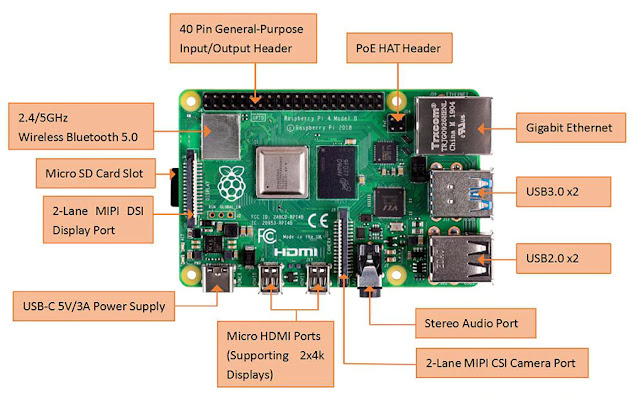Arduino and Raspberry Pi for Electrical Systems
https://nomad-power-system.blogspot.com/2020/04/arduino-and-raspberry-pi-for-electrical-systems.html
Arduino and Raspberry Pi
1. Arduino
Arduino an open source hardware and software platform. Arduino hardware (microprocessor boards) was born in the Italian town of Ivrea, in order to build applications that interact with each other or the environment more smoothly. The hardware includes an open source circuit board designed on the basis of an 8-bit AVR Atmel processor, or 32-bit ARM Atmel. Current models are equipped with a USB interface, 6 analog input pins, 14 digital I / O pins compatible with various expansion boards.
Introduced in 2005, Arduino designers strive to provide an easy, inexpensive way for hobbyists, students and professionals to create devices that can interact with environment via sensors and actuators. Common examples for beginner lovers include simple robots, temperature control and motion detection. Along with it is an integrated development environment (IDE) that runs on regular personal computers and allows users to write programs for Aduino in C or C ++ languages.
Arduino boards can be ordered either as a built-in kit or as a DIY kit. Hardware design information is provided publicly so that anyone who wants to make their own Arduino circuit can do it by themselves (open source). It is estimated that in the middle of 2011 more than 300,000 official Arduino circuits were commercially produced, and by 2013 about 700,000 official circuits were delivered to consumers.
Check the Arduino:
2. Raspberry Pi
The Raspberry Pi is a word for computers that only have a circuit board (also called an embedded computer) the size of a credit card, developed in the UK by the Raspberry Pi Foundation with the original purpose of promoting teach basic computer science in schools and developing countries.
The original Raspberry Pi and the original Raspberry Pi 2 are manufactured in a variety of configurations through production licensing agreements with Newark element14 (Premier Farnell), RS Components and Egoman. These companies sell Raspberry Pi online. Egoman produces a single distribution version in Taiwan, which can be distinguished from other Pis because of their red color and lack of FCC / CE mark. Hardware is the same for all manufacturers.
The Raspberry Pi was originally based on the system on a Broadcom BCM2835 (SoC) chip, including an ARM1176JZF-S 700 MHz processor, VideoCore IV GPU, and was originally shipped with 256 MB RAM, then Upgrades (models B and B +) up to 512 MB. The board also has Secure Digital (SD) sockets (models A and B) or MicroSD (models A + and B +) used as boot devices and continuous storage.
In 2014, the Raspberry Pi Foundation released the Compute Module, packing a BCM2835 with 512 MB of RAM and an eMMC flash chip into a module for use as part of an embedded system.
This organization provides Debian and Arch Linux ARM for users to download. Tools available for Python as the main programming language, support for BBC BASIC (via RISC OS image or Brandy Basic clone for Linux), C, C ++, Java, Perl and Ruby.
As of June 8, 2015, about 5-6,000,000 Raspberry Pi circuits have been sold. Once the UK's fastest-selling personal computer, the Raspberry Pi was the second most delivered device after Amstrad PCW, "Personal Computer Word-processor," sold 8 million units.
In early February 2015, the next generation of Raspberry Pi, Raspberry Pi 2, was released. This new computer board first has only one configuration (model B) and is equipped with SoC Broadcom BCM2836, with a 4-core ARM Cortex-A7 CPU and a VideoCore IV dual-core GPU; 1 GB RAM with remaining specifications similar to those of previous B + models. The Raspberry Pi 2 retains the same price of $ 35 compared to the Model B, with the A + model priced at $ 20 still being sold.
Most Pi circuits are manufactured at a Sony factory in Pencoed, Wales; Some are made in China or Japan
 | |
| Raspberry Pi 4 |
Electrical Systems
The power system needs energy to mine or extract it.
You can start with wind, solar, etc. But if they don't have enough electricity to power your home, then you can control it automatically by combining Arduino with Raspberry Pi.
We only need the idea, and know how to use the functions on Arduino, then Arduino will set up the circuit board for us quickly, and optimize.
We can also create our own power system, from using the power source of electricity right at the grid to setting up a process or electrical system at will.
The special thing is that we can harness electricity from electricity combined with the electricity potential of the earth.
See details:
✰* Revealed At Last: Ancient Invention Generates Energy-On-Demand
✔ Nikola Tesla’s method of magnifying electric power by neutralizing the magnetic counter-forces in an electric generator
Generates Energy-On-Demand: Easy Power Plan Will Change Our World Forever
✔ Currents are 180 out of phase with each other, Lenz's law naturally is broken
✔ Generate generators without rotating motion, but based on the principle of rotating magnets. Because magnetism varies based on electronic circuit design: coils, capacitors, Negative resistance, etc.The change of magnetism does not require the rotation of the magnet.










